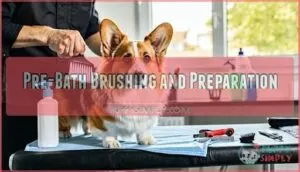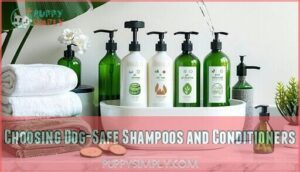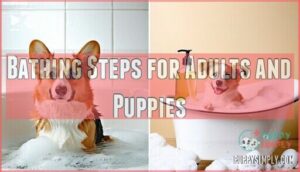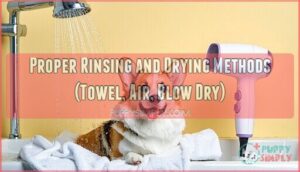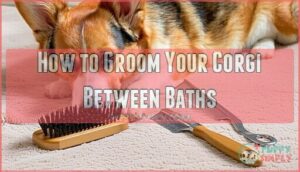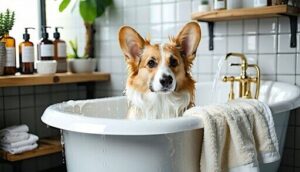This site is supported by our readers. We may earn a commission, at no cost to you, if you purchase through links.
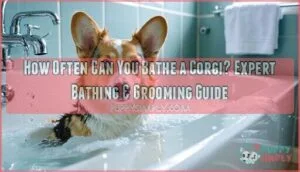
The answer isn’t as simple as a fixed schedule. Most Corgis thrive with baths every four to eight weeks, but your dog’s lifestyle, skin sensitivity, and time spent outdoors can shift that window considerably. Over-bathing strips essential oils from their skin and disrupts the protective barrier that keeps infections at bay, while under-bathing allows grime to build up and trigger scratching or hot spots.
Getting the timing right means understanding your Corgi’s individual needs and recognizing the signs that it’s time to lather up.
Table Of Contents
Key Takeaways
- Most Corgis need baths every four to eight weeks, but your dog’s activity level, outdoor exposure, and skin health should guide the schedule more than a fixed timeline.
- Over-bathing strips the natural oils that protect your Corgi’s skin barrier, leading to dryness, irritation, and increased infection risk, while under-bathing allows dirt and allergens to accumulate.
- Signs your Corgi needs an off-cycle bath include strong odor, visible dirt on their belly and paws, a greasy or tacky coat texture, or excessive scratching that signals skin problems.
- Regular brushing between baths—especially during spring and fall shedding seasons—removes loose undercoat and reduces the need for frequent washing while maintaining coat health.
How Often Can You Bathe a Corgi?
Bathing your Corgi isn’t one-size-fits-all—it depends on their lifestyle, coat condition, and skin health. Too many baths can strip natural oils, while too few leave them dirty and uncomfortable.
Let’s figure out what works best for your dog.
Recommended Bathing Frequency
Most Corgis do well with a bath every four to eight weeks, though your dog’s lifestyle and coat condition should guide the final schedule. You can bathe your Corgi more frequently if they roll in mud or develop an odor, but stick to ideal intervals of every two months for routine maintenance.
Puppies often need gentler, less frequent bathing—every six to eight weeks works well. Senior Corgis may require adjusted bathing frequency based on mobility and skin sensitivity.
Risks of Over-Bathing
Bathing too often strips away your Corgi’s natural oils, which protect their skin and keep their coat healthy. Weekly bathing can disrupt skin barrier function, leading to dryness, itchiness, and increased dander. Over-bathing also throws off your dog’s skin microbiome balance, making infections more likely. Understanding a dog’s natural oil protection is key to a healthy grooming routine.
You might notice:
- Flaky, dry patches that won’t go away
- Dull, brittle fur that loses its shine
- Greasy skin as oil glands overcompensate
- Frequent scratching or redness
- More frequent skin infections or hot spots
Stick to that two-month schedule to avoid these skin problems and maintain your Corgi’s coat quality.
Signs Your Corgi Needs a Bath
Even with the right schedule, you’ll need to watch for signs that your Corgi needs an off-cycle bath before that two-month mark rolls around. Trust your nose first—a strong odor means it’s time. Check for visible dirt on their belly and paws after muddy walks.
| Sign | What to Look For | Action Needed |
|---|---|---|
| Odor Check | Musty or strong smell | Bath within days |
| Visible Dirt | Mud on coat, belly | Spot clean or full bath |
| Coat Texture | Tacky, greasy feel | Bath and skin condition review |
Excessive scratching or a tacky coat texture signals skin problems that need attention beyond regular dog grooming.
What Factors Influence Bathing Frequency?
Not every Corgi needs a bath on the same schedule. Your dog’s lifestyle, coat health, and environment all play a role in determining how often they should hit the tub.
So what actually determines how often your Corgi needs a bath?
Activity Level and Outdoor Exposure
If your Corgi spends hours romping through parks, forests, or muddy trails, they’ll naturally need more frequent baths than a couch potato who rarely ventures beyond the backyard. Outdoor adventures mean muddy paws, dirt-caked coats, and exposure to allergens like pollen.
Rural dogs often face more dirt than urban pups, and seasonal activities—think spring rain or fall hikes—can increase your bathing frequency. Match your dog grooming schedule to your Corgi’s exercise frequency and environment for best pet hygiene.
Coat Condition and Shedding
Your Corgi’s double coat sheds year-round, with major blowouts twice a year that can dramatically affect how often you’ll need to bathe them.
During shedding seasons—usually spring and fall—regular brushing removes loose undercoat before bathing, making the process more effective.
A healthy diet aids coat texture and reduces excessive shedding, while proper dog coat care between baths keeps your Corgi comfortable and minimizes the need for frequent washing.
Skin Health and Allergies
When your Corgi has sensitive skin or dog skin conditions like atopic dermatitis, bathing frequency becomes a balancing act. Over-bathing risks stripping the skin microbiota that protects against allergen exposure and flea infestation.
Monthly baths generally suffice for allergy prevention, but dogs with severe allergies may benefit from twice-weekly washing to reduce environmental allergens.
A vet visit may be needed to diagnose dog shampoo allergies properly. Always choose hypoallergenic shampoo ingredients—avoid products with isothiazolinones or harsh chemicals that trigger reactions in sensitive skin.
Environmental Factors (Weather, Dirt, Pollen)
When rain, mud, or spring pollen rolls through your neighborhood, your Corgi’s bath schedule will need to flex accordingly. Dogs that romp outdoors during allergy season face higher pollen exposure, while wet weather means muddy paws track dirt indoors.
Key environmental triggers:
- Seasonal allergies spike in spring and fall, requiring more frequent washing to remove allergens from the coat
- Weather impact matters—rainy days mean extra baths to clean muddy coats and protect dog skin care routines
- Air quality affects how quickly your Corgi’s coat collects outdoor debris, influencing your Corgi grooming guide timeline
How to Properly Bathe Your Corgi
Bathing your Corgi isn’t complicated, but doing it right makes all the difference for their coat and skin health.
You’ll need to follow a few simple steps to keep those natural oils intact while getting rid of dirt and grime.
Before you grab the shampoo, there are some basics worth knowing.
Pre-Bath Brushing and Preparation
Before your Corgi even gets near the tub, brushing out their double coat can save you from wrestling with tangled, waterlogged fur later on. Weekly brushing with a slicker brush or undercoat rake loosens dead hair and prevents matting.
Don’t skip combing through trouble spots like behind the ears—mat removal gets trickier when wet. Quick nail and ear checks now make bath time smoother.
Choosing Dog-Safe Shampoos and Conditioners
Not all shampoos are created equal—what’s gentle for humans can wreak havoc on a dog’s more sensitive skin pH. Look for products specifically formulated for dogs:
- Hypoallergenic options with oatmeal shampoo soothe irritation
- pH-balanced formulas protect your Corgi’s skin barrier
- Puppy shampoos offer extra-gentle cleansing for young dogs
- Medicated shampoos target dog skin conditions when prescribed
Check ingredients to avoid harsh chemicals, and consider cucumber and aloe scented conditioner for added moisture.
Bathing Steps for Adults and Puppies
Once you’ve gathered your supplies, bathing itself is pretty simple—though you’ll handle an adult Corgi differently than a puppy.
Puppies need lukewarm water and diluted shampoo to protect their delicate skin. Adults tolerate slightly warmer temperatures.
For both, work from neck to tail, avoiding sensitive areas like eyes and ears. Lather gently, especially around the belly where Corgis collect the most dirt.
Proper Rinsing and Drying Methods (Towel, Air, Blow Dry)
After lathering, rinsing becomes the most important step—leftover shampoo irritates skin, triggers itching, and can leave your Corgi’s coat looking dull or greasy. Use lukewarm water and rinse until the water runs completely clear.
For drying, towel drying works well for most Corgis. Air drying is fine in warm weather, but blow-drying on low heat speeds things up—just avoid high temperatures that risk burns.
How to Groom Your Corgi Between Baths
Between baths, regular grooming keeps your Corgi’s coat healthy and prevents problems from building up. You don’t need water and shampoo to maintain your dog’s hygiene and appearance.
Your routine should include these grooming essentials.
Brushing Techniques for Shedding
Your Corgi’s double coat sheds year-round, with heavier seasonal shedding in spring and fall. Brush regularly to manage loose fur and prevent matting.
Use a slicker brush for the topcoat and a deshedding tool to reach the undercoat. During shedding season, brush at least three times weekly—daily when they’re blowing their coat.
Work in sections, brushing with the hair’s direction to remove loose undercoat without irritating skin.
Nail Trimming and Paw Care
While keeping your Corgi’s coat in check matters, those little paws hitting the pavement day after day need attention too. Trim nails every three to four weeks using dog nail clippers or a nail grinder—overgrown nails can cause discomfort and gait problems.
Check paw pads regularly for cracks, cuts, or debris lodged between toes, and wipe them clean after muddy walks to prevent injuries.
Ear and Eye Cleaning
Those perked-up ears and bright eyes need a weekly once-over to spot dirt, discharge, or early infection signs before they escalate.
- Use vet-recommended cleaning solutions for ear wax removal—never cotton swabs deep in the canal
- Gently wipe tear stains with a damp cloth to prevent buildup and irritation
- Watch for redness, odor, or excessive discharge that signals infection prevention needs
- Ask your veterinarian about proper pet care techniques during routine grooming visits
Regular Corgi grooming tips like these keep your dog comfortable and healthy between baths.
Maintaining Dental Hygiene
Brushing your dog’s teeth a few times a week can prevent painful dental disease and extend their life by years. Use dog-specific toothpaste—never human brands—and focus on gentle brushing techniques along the gum line where tartar builds up.
Dental chews and toys help with tartar control between sessions, freshening breath while supporting gum health. If you spot bleeding gums or persistent bad breath, schedule a vet checkup to protect your Corgi’s overall dog health.
Which Products Are Best for Corgi Bathing?
Choosing the right products protects your Corgi’s skin while keeping their coat healthy between washes.
The shampoo and conditioner you select can make the difference between a comfortable dog and one dealing with dryness or irritation.
Let’s break down what actually works for Corgis—and what you should skip.
Oatmeal Shampoo for Sensitive Skin
If your Corgi’s skin is prone to get red, itchy, or irritated after baths, oatmeal shampoo can be a gentle solution that soothes inflammation while still cleaning effectively.
Look for dog shampoos with colloidal oatmeal as a key ingredient—it forms a protective barrier that locks in moisture and provides irritation relief.
Your vet can recommend specific brands suited to your dog’s skin conditions, or you can explore DIY recipes using plain oatmeal if you prefer natural dog grooming supplies.
Benefits of Cucumber Aloe Conditioner
When you want to condition your Corgi’s double coat without weighing it down or leaving a greasy residue, cucumber aloe conditioner offers lightweight hydration that rinses clean and leaves fur soft to the touch.
The natural ingredients provide skin soothing and allergy relief, while aloe delivers coat hydration that calms irritation.
You’ll notice itch reduction after bathing, making grooming sessions more comfortable for your Corgi’s sensitive skin.
Avoiding Harsh Chemicals and Irritants
Reading shampoo labels protects your Corgi from harmful ingredients that strip natural oils and trigger dog skin conditions. Over 60% of conventional pet shampoos contain sulfates linked to skin irritation, and nearly half include parabens that may disrupt hormone function. Choose sulfate-free options with natural preservatives like rosemary extract instead of formaldehyde-releasing compounds.
Topical treatments matter because skin allergies now account for 16% of canine insurance claims, with harsh shampoo exposure being a preventable cause.
- Look for organic certification to verify safer shampoo ingredients and reduce chemical exposure by over 80%
- Avoid formaldehyde-releasing preservatives like Quarternium-15, which cause skin blistering and itching
- Skip artificial fragrances found in 70% of mass-market products—they’re common allergy risks for sensitive Corgis
- Choose plant-based cleansers such as Castile soap for effective cleaning without toxicity concerns
- Check for soothing ingredients like oatmeal and aloe vera, proven to strengthen skin barriers and reduce irritation
Tips for Selecting Grooming Supplies
Choosing the right grooming tools can make the difference between a relaxed bath routine and a wrestling match with a wet, unhappy dog. Look for slicker brush types that work with Corgi double coats, guillotine-style nail clippers sized for medium breeds, and absorbent drying towels that cut blow-dry time.
Don’t forget gentle ear cleaners and a flea comb for weekly checkups between shampoo sessions.
Frequently Asked Questions (FAQs)
How do I dry my Corgi’s ears thoroughly after a bath?
After bathing, the devil is in the details—especially with those perked Corgi ears.
Gently wipe the outer ear with a soft, dry cloth or cotton ball, avoiding deep insertion. Use vet-approved ear drying tools to remove moisture and prevent infection risk signs like redness or odor.
Can I bathe my Corgi puppy differently?
Yes, puppies need gentler care. Their sensitive skin requires mild puppy shampoo and less frequent bathing—wait until they’re at least eight weeks old.
Keep bath time short, make sure of thorough rinsing, and keep them warm afterward to prevent chilling.
How do I handle water-resistant Corgi coats?
Corgis sport a thick double coat that naturally repels water—think raincoat, not sponge.
You’ll need to work shampoo through to the undercoat with thorough massaging motions, then rinse completely. Brushing beforehand helps water penetrate deeper during bathing.
What water temperature is safest for bathing?
Lukewarm water works best for Corgi bathing—think around 98-102°F, close to their body temperature. You don’t want anything too hot or too cold, since puppies are especially sensitive to temperature extremes. Test the water on your wrist before starting.
Should I bathe before or after exercise?
Timing is everything—don’t jump the gun. Bathe your Corgi after exercise, not before.
Post-exercise hygiene matters because sweat and debris settle into the coat during activity. This approach maintains proper Corgi bathing frequency while supporting effective dog grooming and overall Corgi care.
How do I prevent ear infections during baths?
Place cotton balls gently in your Corgi’s ear canals before bathing to prevent water entry.
After the bath, remove them carefully and use veterinarian-approved drying techniques and cleaning solutions to maintain dog health.
Conclusion
A client once brought in her Pembroke after following an online "weekly bath" schedule, only to discover flaky skin and constant scratching caused by stripped oils. That experience reinforced a core truth: how often can you bathe a Corgi depends entirely on your dog’s lifestyle, not a rigid calendar.
Watch for odor, visible dirt, or excessive scratching rather than bathing by habit. Your Corgi’s coat evolved to self-regulate—trust it, support it with brushing, and intervene with soap only when truly needed.
Trust your Corgi’s coat to self-regulate—bathe only when odor, dirt, or scratching signal actual need, not habit
- https://www.dogster.com/dog-health-care/how-often-should-i-bathe-corgi
- https://articles.hepper.com/how-often-should-you-bathe-a-corgi/
- https://www.rover.com/blog/how-often-should-i-wash-my-dog/
- https://www.reddit.com/r/corgi/comments/wh42hv/how_often_do_you_bath_your_corgi_is_there_too/
- https://pmc.ncbi.nlm.nih.gov/articles/PMC10446845/


